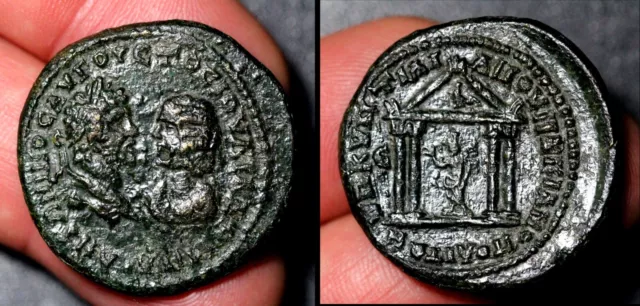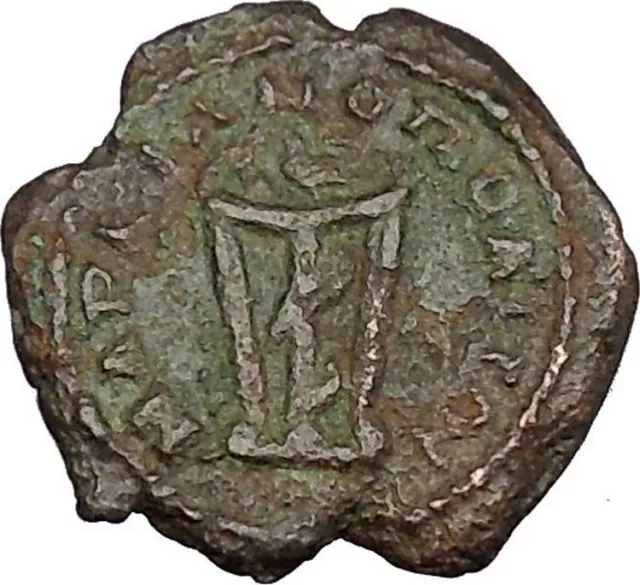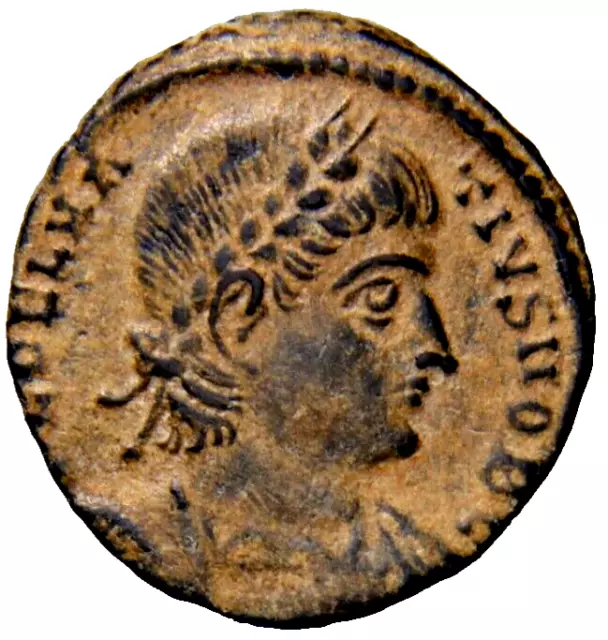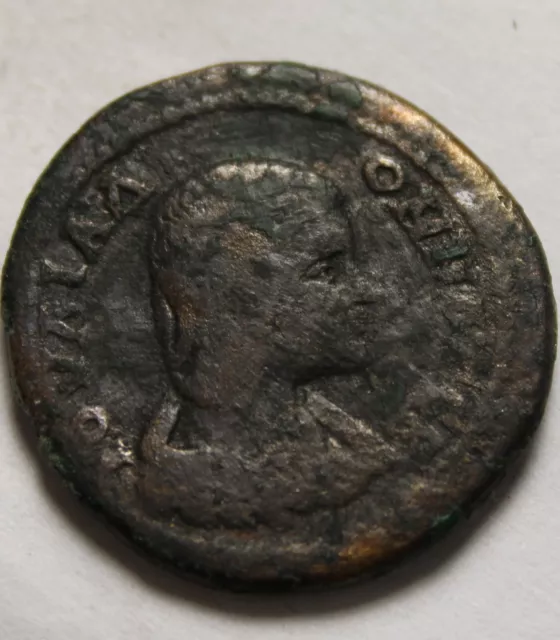Rare genuine ancient Roman coin Julia Domna Marcianopolis Moesia Inf. 3 graces
Seller: cameleoncoins ✉️ (19,898) 98.7%,
Location: Woodland Hills, California, US,
Ships to: WORLDWIDE & many other countries,
Item: 304894106894
Rare genuine ancient Roman coin Julia Domna Marcianopolis Moesia Inf. 3 graces. One original ancient Roman coin of: Julia Domna, wife of Septimius Severus
Marcianopolis, Moesia Inferior. AE 24-25mm. 8.39gm. Remains of genuine brown patina and earthen encrustation. Obv./ IOYΛIA ΔOMNA CEB, draped bust right,
hair in bun. Rev./ / MAΡKIANOΠOΛITΩN, statuary group of the Three Graces. AMNG
603.
Coin is in good condition and very nice and rare inclusion to the finest collection. Authenticity guaranteed. COA included!!! In Greek mythology, the Charites /ˈkærɪtiːz/ (Χάριτες [kʰárites]), singular Charis, or Graces, were three or more goddesses of charm, beauty, nature, human creativity, goodwill, and fertility. Hesiod names three – Aglaea ("Shining"), Euphrosyne ("Joy"), and Thalia ("Blooming") – and names Aglaea as the youngest and the wife of Hephaestus. In Roman mythology they were known as the Gratiae, the "Graces". Some sources use the appellation "Charis" as the name of one of the Charites, and equate her with Aglaea, as she too is referred to as the wife of Hephaestus. The Charites were usually considered the daughters of Zeus and Oceanid Eurynome. Rarely, they were said to be daughters of Dionysus and Coronis or of Helios and the Naiad Aegle or of Hera by an unnamed father. Other possible names of their mother by Zeus are Eurydome, Eurymedousa, or Euanthe. Homer identified them as part of the retinue of Aphrodite. The Charites were also associated with the Greek underworld and the Eleusinian Mysteries. In post-classical painting and sculpture, the three Charites are often depicted naked or almost naked, but during the Archaic and Classical periods of Greece, they were typically depicted as fully clothed. Members of the Charites The name and number of goddesses associated with the Charites varied, although they usually numbered three. Alternate names to Aglaea, Euphrosyne, and Thalia given in literature included: Damia ("Earth Mother"), Auxesia ("Spring Growth"), Cleta ("Renowned"), Phaenna ("Bright"), Hegemone ("Leader"), Peitho ("Persuasion"), Paregoros ("Consolation"), Pasithea ("Relaxation"), Charis ("Grace"), and Kale ("Beauty"). Alternatively, an ancient vase painting attests the following names as: Antheia ("Blossoms"), Eudaimonia ("Happiness"), Euthymia ("Good Mood"), Eutychia ("Good Luck"), Paidia ("Play"), Pandaisia ("Banquet"), and Pannychis ("Night Festivities"), all refer to the Charites as patronesses of amusement and festivities. Pausanias interrupts his Description of Greece (Book 9.35.1–7) to expand upon the various conceptions of the Charites that developed in different parts of mainland Greece and Ionia: The Boeotians say that Eteocles was the first man to sacrifice to the Graces. Moreover, they are aware that he established three as the number of the Graces, but they have no tradition of the names he gave them. The Lacedaemonians, however, say that the Graces are two, and that they were instituted by Lacedaemon, son of Taygete, who gave them the names of Cleta ("Sound" or "Renowned") and Phaenna ("Light" or "Bright"). These are appropriate names for Graces, as are those given by the Athenians, who from of old have worshipped two Graces, Auxo ("Increase" or "Growth") and Hegemone ("Leader" or "Queen"), until Hermesianax added Peitho ("Persuasion") as a third. It was from Eteocles of Orchomenus that we learned the custom of praying to three Graces. And Angelion and Tectaus, sons of Dionysus, who made the image of Apollo for the Delians, set three Graces in his hand. Again, at Athens, before the entrance to the Acropolis, the Graces are three in number; by their side are celebrated mysteries which must not be divulged to the many. Pamphos (Πάμφως or Πάμφος) was the first we know of to sing about the Graces, but his poetry contains no information either as to their number or about their names. Homer (he too refers to the Graces) makes one the wife of Hephaestus, giving her the name of Charis ("Grace")." He also says that Sleep was a lover of Pasithea ("Hallucination"), and in the speech of Sleep there is this verse: Verily that he would give me one of the younger Graces. Hence some have suspected that Homer knew of older Graces as well. Hesiod in the Theogony (though the authorship is doubtful, this poem is good evidence) says that the three Graces are daughters of Zeus and Eurynome, giving them the names of Aglaia, Euphrosyne and lovely Thalia. The poem of Onomacritus agrees with this account. Antimachus, while giving neither the number of the Graces nor their names, says that they are daughters of Aegle and the Sun. The elegiac poet Hermesianax disagrees with his predecessors in that he makes Persuasion also one of the Graces. Nonnus gives their three names as Pasithea, Peitho and Aglaia. Sostratus gives the names as Pasithea, Cale ("Beauty") and Euphrosyne; Pasithea for Aglaia and Cale for Thalia, Euphrosyne is unchanged. In Sparta, only Cleta and Phaenna were counted. Role in mythology The Charites' major mythological role was to attend the other Olympians, particularly during feasts and dances. They attended Aphrodite by bathing and anointing her in Paphos before her seduction of Ankhises and after she left Olympus when her affair with Ares is found out. Additionally, they are said to weave or dye her peplos. Along with Peitho, they presented Pandora with necklaces to make her more enticing. Pindar stated the Charites arranged feasts and dances for the Olympians. They also danced in celebration of the birth of Apollo with Aphrodite, Hebe, and Harmonia. They were often referenced as dancing and singing with Apollo and the Muses. Pindar also referred to them as the guardians of the ancient Minyans and the queens of Orchomenus who have their thrones beside Apollo's. The Charites appear to have a connection to Hera, where some ancient authors reference her as their nurse. In the Iliad, as part of her plan to seduce Zeus to distract him from the Trojan War, she offers to arrange Hypnos's marriage to Pasithea, who is referred to as one of the younger Charites. Aglaea or Charis had a role as the wife of the smith god Hephaestus. In the Iliad, Aglaea invites Thetis into their shared home on Olympus so that the latter may ask for Hephaestus to forge armor for her son Achilles. Some scholars have interpreted this marriage as occurring after Hephaestus's divorce from Aphrodite due to her affair with Ares being exposed. Notably, however, some scholars, such as Walter Burkert, support that the marriage of Hephaestus and Aphrodite as an invention of the Odyssey, since it is not represented within other Archaic or Classical era literature or arts, and it does not appear to have a connection to cult. Cult The Three Graces, Antonio Canova's first version, now in the Hermitage Museum The cult of the Charites is very old, with their name appearing to be of Pelasgian, or pre-Greek, origin rather than being brought to Greece by Proto-Indo-Europeans. The purpose of their cult appears to be similar to that of nymphs, primary based around fertility and nature with a particular connection to springs and rivers. One of the earliest centres of worship for the Charites was the Cycladic Islands including Paros, with epigraphical evidence for a cult to the Charites dating to the 6th century B.C.E. on the island of Thera. Scholars have interpreted them as chthonic deities connected to fertility due to the absence of wreaths and flutes in ceremonies. An aetiological explanation for the lack of music and garlands was from a myth involving Minos. He was said to have been sacrificing to the Charites on the island of Paros when he learned of his son's death in Athens and stopped the music and ripped off his garlands in grief. Dance, however, appears to be strongly connected with their cult, which is similar to the cults of Dionysus and Artemis. Although the Charites were most commonly depicted in the sanctuaries of other gods, there were at least four temples exclusively dedicated to them in Greece. The temple regarded as their perhaps most important was that in Orkhomenos in Boeotia, where their cult was thought to have originated. There were also temples to the Charites in Hermione, Sparta, and Elis.[30] A temple was dedicated to the Charites near the Tiasa river in Amyclae, Laconia that was reportedly founded by the ancient King of Sparta, Lacedaemon. Les Trois Grâces by James Pradier, 1831. Louvre. In Orkhomenos, the goddesses were worshipped at a very ancient site with a trio of stones, which is similar to other Boiotian cults to Eros and Herakles. The local river Kephisos and the Akidalia (or Argaphia) spring was sacred to the three goddesses. Orkhomenos was an agriculturally prosperous city because of the marshy Kopaic plain, and the Charites were offered a portion of the produce. Regarding the foundation of their cult in Orkhomenos, Strabo wrote: Eteokles, one of those who reigned as king at Orkhomenos, who founded a temple of the Kharites, was the first to display both wealth and power; for he honored these goddesses either because he was successful in receiving graces, or in giving them, or both. For necessarily, when he had become naturally inclined to kindly deeds, he began doing honor to these goddesses; and therefore he already possessed this power. In cult, the Charites were particularly connected with Apollo and appear to be connect to his cult on Delos, however, this connection is not present in other cults to Apollo. In the Classical era and beyond, the Charites were associated with Aphrodite in connection to civic matters. Visual art Despite the Charites often being depicted naked entwined in an embrace, this appears to be a later development, as in depictions from Archaic and Classical Greece, they are finely dressed. In contrast, 3rd century B.C.E. poets Callimachus and Euphorion describe the trio as being nude. The earliest representation of these goddesses was found in a temple of Apollo in Thermon dated to the 7th to 6th century B.C.E.[29] It is possible, however, that the Charites are represented on a Mycenean golden seal ring that depicts two female figures dancing in the presence of a male figure, who has been interpreted as Hermes or Dionysus. Another early representation of the Charites, from a relief at the Paros colony of Thasos dated to the beginning of the 5th century B.C.E., shows the Charites with Hermes and either Aphrodite or Peitho, which marked the entrance to the old city. The opposite side of the relief shows Apollo being crowned by Artemis with nymphs in the background. At the entrance of the Akropolis, there was a famous Classical era relief of the Charities and Hermes, and the popular belief was that the sculptor was Sokrates, although this is very unlikely. One of the earliest known Roman representations of the Graces was a wall painting in Boscoreale dated to 40 B.C.E, which also depicted Aphrodite with Eros and Dionysus with Ariadne. The group may have also appeared on a small number of coins to symbolize the union between Marcus Aurelius and Faustina Minor and on other coins they were depicted in the hands of Juno or Venus. The Graces were common subject matter on Roman sarcophagi, and they were depicted on several mirrors. On the representation of the Graces, 2nd century C.E. geographer Pausanias wrote: Who it was who first represented the Graces naked, whether in sculpture or in painting, I could not discover. During the earlier period, certainly, sculptors and painters alike represented them draped. At Smyrna, for instance, in the sanctuary of the Nemeses, above the images have been dedicated Graces of gold, the work of Bupalus; and in the Music Hall in the same city there is a portrait of a Grace, painted by Apelles. At Pergamus likewise, in the chamber of Attalus, are other images of Graces made by Bupalus; and near what is called the Pythium there is a portrait of Graces, painted by Pythagoras the Parian. Socrates too, son of Sophroniscus, made images of Graces for the Athenians, which are before the entrance to the Acropolis. Also, Socrates was known to have destroyed his own work as he progressed deeper into his life of philosophy and search of the conscious due to his iconoclastic attitude towards art and the like. All these are alike draped; but later artists, I do not know the reason, have changed the way of portraying them. Certainly to-day sculptors and painters represent Graces naked. The Three Graces, from Carle van Loo (1763) The Three Graces, Raphael, 1504–1505. During the Renaissance, the Roman statue group of the three graces in the Piccolomini library in Duomo di Siena inspired most themes. The Charites are depicted together with several other mythological figures in Sandro Botticelli's painting Primavera. Raphael also pictured them in a painting now housed in Chantilly in France. Among other artistic depictions, they are the subject of famous sculptures by Antonio Canova and Bertel Thorvaldsen. A group of three trees in the Calaveras Big Trees State Park are named "The Three Graces" after the Charites.
| Julia domna.jpgJulia Domna - Augusta 193-217 A.D. | Wife of Septimius Severus | Mother of Caracalla and Geta | Sister of Julia Maesa | Aunt of Julia Soaemias and Julia Mamaea | Great-aunt of Elagabalus and Severus Alexander | Mother-in-law of Plautilla | Julia Domna (unknown date–217) was a member of the Severan dynasty of the Roman Empire. Empress and wife of Roman Emperor Lucius Septimius Severus and mother of Emperors Geta and Caracalla, Julia was among the most important women ever to exercise power behind the throne in the Roman Empire. // Family background Julia was of Syrian origin from the ancient city of Emesa. Her ancestors were Kings Priest of the famous temple of Baal. The family lost its kingdom to Rome but continued domination of the temple of Baal. The family had an enormous wealth and was promoted to Roman senatorial aristocracy. She was the youngest daughter of high-priest Gaius Julius Bassianus and her eldest sister was Julia Maesa. Reign In the late 180s, Julia married future Emperor Septimius Severus who himself was in part of Punic background. The marriage proved to be a happy one and Severus cherished his wife and her political opinions, since she was very well read and keen on philosophy. Together, they had two sons, Lucius Septimius Bassianus (Caracalla) in 186 and Publius Septimius Geta in 189. Civil War When Severus became emperor in 193 he had a civil war waiting for him, against rivals such as Pescennius Niger and Clodius Albinus. Julia accompanied him in his campaigns in the East, an uncommon event in a time when women were expected to wait in Rome for their husbands. Nevertheless, she remained with the emperor and among the several proofs of affection and favour are the minting of coins with her portrait and the title mater castrorum (mother of the camp). Julia now had complete power and ruled behind the Roman Empire. Many early Romans disliked the fact of her ruling over the throne when Septimius Severus was at war. Controversy and transition of power As empress, Julia was often involved in intrigues and had plenty of political enemies who accused her of treason and adultery. None of these accusations were proven, Severus continued to favour his wife and insisted on her company in the campaign against the Britons that started in 208. When Severus died, in 211 in York, Julia became the mediator between their two sons. Caracalla and Geta who were to rule as joint emperors, according to their father's wishes expressed on his will. But the two young men were never fond of each other and quarrelled frequently. Geta was murdered by Caracalla's soldiers in the same year. Caracalla was now sole emperor, but his relations with his mother were difficult, as attested by several sources, probably due to his involvement in Geta's murder. Nevertheless, Julia accompanied Caracalla in his campaign against the Parthian empire in 217. During this trip, Caracalla was assassinated and succeeded (briefly) by Macrinus. On hearing about the rebellion, Julia chose to commit suicide. Her body was brought to Rome and placed in the Sepulcrum C. et L. Caesaris (perhaps a separate chamber in the Mausoleum of Augustus). Later, however, both her bones and those of Geta were transferred by her sister Julia Maesa to the Mausoleum of Hadrian. She was later deified. |
- Condition: Authenticity guaranteed. COA included!!!
- Historical Period: Roman: Provincial (100-400 AD)
- Year: 193AD
- Era: Ancient
PicClick Insights - Rare genuine ancient Roman coin Julia Domna Marcianopolis Moesia Inf. 3 graces PicClick Exclusive
- Popularity - 0 watchers, 0.0 new watchers per day, 367 days for sale on eBay. 0 sold, 1 available.
- Best Price -
- Seller - 19,898+ items sold. 1.3% negative feedback. Great seller with very good positive feedback and over 50 ratings.
People Also Loved PicClick Exclusive

MOESIA - Caracalla & Julia Domna AE 5 Assaria, Marcianopolis, Temple (t052)
£83.01 0 Bids or Buy It Now 5d 2h
MOESIA - Caracalla & Julia Domna AE 5 Assaria, Marcianopolis, Arch (t032)
£65.47 0 Bids or Buy It Now 5d 2h
ELAGABALUS Marcianopolis Moesia Rare Ancient Roman Coin Serpent TRIPOD i48376
£76.00 Buy It Now 28d 18h
CARACALLA & JULIA DOMNA Marcianopolis Ancient 198AD Roman Coin TYCHE i79047
£107.26 Buy It Now 7d 19h
CARACALLA & JULIA DOMNA Marcianopolis Ancient 198AD Roman Coin TYCHE i79150
£143.66 Buy It Now 15d 15h
CERTIFIED GENUINE Ancient Roman Coin RARE Gloria DELMATIUS SMANH Soldiers
£160.03£159.39 Buy It Now or Best Offer
DESERT PATINA Genuine Ancient Roman Coin VOT Wreath of Success RQ Constantine I
£59.83£49.66 Buy It Now or Best Offer
CERTIFIED GENUINE Ancient Roman Coin Constantine I Nummus TICINUM Vot TT Wreath
£69.48£57.67 Buy It Now or Best Offer 1 watcher
1 watcherRare Genuine ancient Roman silver coin Julia Domna denarius Isis horus rudder
£71.57 0 Bids or Best Offer 2d 22h


